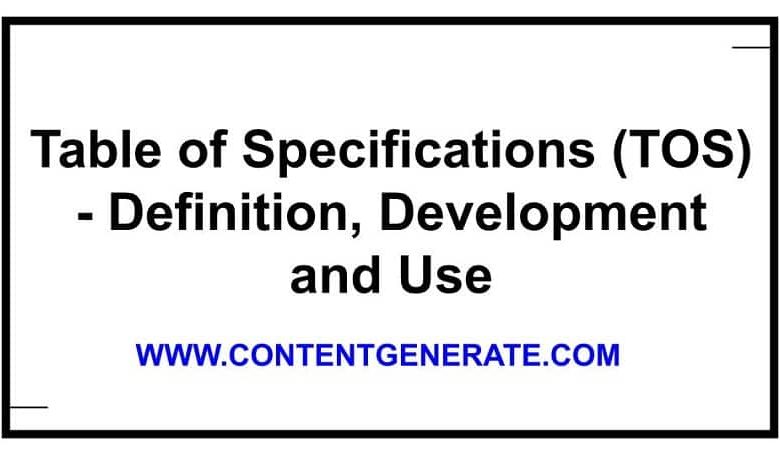Table of Specifications – Definition, Development and Implementation

The classroom achievement test is an important assessment tool used in education. Scores achieved in these tests are used to make decisions to improve classroom instruction. The scores will not help make valid judgments on student learning if the test is not valid. Hence, to improve the validity of student performance evaluation, test developers and teachers develop and use a table of specifications (TOS).
This article defines the TOS and explains its purpose in standardized, internal, and daily classroom instruction. Moreover, the article provides step-by-step guidance on how to develop a TOS in the context of a mid Term Examination syllabus of grade 10.
Contents
What is a Table of Specification (TOS?
A table of specifications (TOS) is a chart that teachers and test developers use in item writing. It ensures that the test developed assesses the content taught and the learning experience given to the students. It also helps align the test with learning objectives and their cognitive levels. Moreover, it defines the amount of the test to assess each objective. In nutshell, a Table of Specifications precisely illustrates the scope and focus of a test.
What is the purpose of the Table of Specification?
The basic purpose of making a TOS is to enable teachers to:
1. determine the content area of the test;
2. develop items that reflect student learning across cognitive levels.
3. allocate a specific amount of instructional time needed for each topic/SLOs.
4. make sure that no important learning objective is left out of the assessment;
5. produce valid test items;
6. assess learning objectives that are actually included in the instructional process;
7. ensure proportional emphasis on each learning objective.
What are the important tips to develop a table of specifications?
The development of TOS has three steps. In the first step, topics along with cognitive levels are tabulated. The table mentions the total number and percentage share of student learning outcomes (SLOs) and their cognitive levels in each topic.
Table 1 illustrates the first phase of the first development of TOS. There are 5 columns in the table. The extreme left column represents the chapters taught. The second column from the left shows SLOs whereas the last three columns represent the cognitive levels i.e. knowledge, understanding, and application in each topic.
Table 1, Table of specification For Midterm Examination. (Based on Cognitive Level: K, U, A)
Topics |
SLOs |
K |
U |
A |
| Major Industries of Pakistan | 6 | 1 | 2 |
3 |
| Trade and Commerce |
4 |
1 | 3 |
– |
| Transportation |
4 |
1 | 1 |
2 |
| Formative Phase of Pakistan (1947-58) |
2 |
– | 2 |
– |
| General Ayub Khan Era |
4 |
– | 1 |
3 |
| Total No. of SLOs |
20 |
3 | 9 |
8 |
|
Percentage (%) |
100 | 15 | 45 | 40 |
|
Marks |
40 | 6 | 18 | 16 |
| Total Marks |
40
|
|||
After the completion of the first step (the tabulation of topics, number of SLOs, and their cognitive distribution), we find out the percentage share of SLOs and marks in each topic as illustrated in Table 2. The table represents topics, no, of SLOs in each topic, percentage share of SLOs, and distribution of marks in columns 1, 2, 3, and 4 respectively.
The formulas given below are used for calculating the percentage share of SLOs and distribution of marks per SLO:
Weight in Percentage = No. of SLOs of the topic × 100 ÷ total no of SLOs
Weight in Marks = Calculated % of Max. Marks
Table 2: Content-wise /Chapter Wise distribution of test syllabus
|
Topics |
No. of SLOs in a topic | % share of SLOs |
Distribution of Marks |
| Major Industries of Pakistan | 6 | 30% | 12 |
| Trade and Commerce | 4 | 20% | 8 |
| Transportation | 4 | 20% | 8 |
| Formative Phase of Pakistan (1947-58) |
2 | 10% | 4 |
| General Ayub Khan Era (1958- 1969) |
4 | 20% | 8 |
Total |
20 | 100% | 40 |
Once done with the calculation/distribution of marks per SLO, the TOS developers move on to the next steps of calculating the number of items per cognitive level i.e. knowledge, understanding, application. All six cognitive levels of Bloom’s taxonomy are not covered in this case. Instead, the test developers at the secondary and higher secondary level distribute SLOs in three cognitive levels of knowledge, understanding, and application. They consider all higher-order thinking levels as part of the application. This is best manifested in Table 3.
The formula given below is used to calculate the weight of items per cognitive level:
The number of items = Maximum marks topic ÷ no. of SLOs X number of SLOs in each cognitive level
Table 3: Cognitive levels distribution of items
| Topics | Allocated Marks | MCQs | K | U | A |
| Major Industries | 12 | 6 | 2 | 4 | 6 |
| Trade and Commerce | 8 | 4 | 2 | 6 | – |
| Transportation | 8 | 4 | 2 | 2 | 4 |
| Formative Phase of Pakistan | 4 | 2 | – | 4 | – |
| Ayub Khan Era | 8 | 4 | – | 2 | 6 |
| Total | 40 | 20 | 6 | 18 | 16 |
Conclusion
There are three crucial steps to follow in the development of TOS. In the first step, we tabulate the topics, SLOs, and cognitive levels of the taught curriculum. In the second step, we tabulate the percentage share of each topic and the distribution of marks for each topic. In the third and last stage, tabulation of the item distribution per cognitive level takes place. The developed TOS informs the item developer to ensure the credibility of items. Assessment experts also make use of TOS in a test review. This review informs if the test is aligned with the taught curriculum or not.



